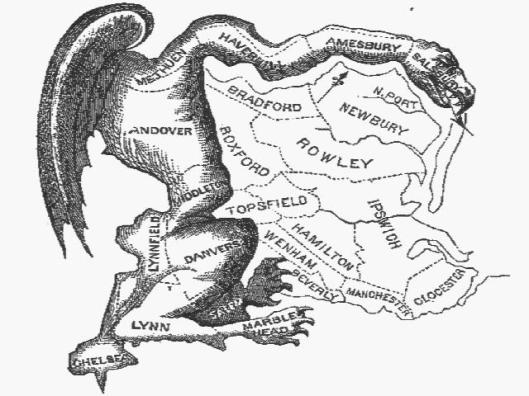Tags
American Politics, Baird, Baird cartoon, Baird cartoons, Boundary changes, comitia centuriata, Congressional districts, corrupt american political practices, Dr Michael McDonald, Elbridge Gerry, George Mason university, Gerrymandering, Incumbent gerrymandering, pack and stack, Partisan gerrymandering, Redistricting, Roman republic, US Politics, Vice President Elbridge Gerry
The original Gerrymander
A fundamental of any democratic system is that there requires to be a meaningful choice available to the electorate at the ballot box for the electorate to exercise its vote. The 2002 congressional election was felt by many, and by Dr Michael McDonald of the Department of International Affairs at George Mason University, Fairfax VA in particular, to have sorely tried that test Out of 435 House races only 40 were considered close enough that the outcome was not already known to a high degree of possibility
So, the country which likes to see itself portrayed as the leader of the free world has elections of a state that would make a Commissar of the Old Soviet Union blush. How on earth can matters have become so sclerotic, so petrified that there is such little change of seats at elections?
Well, one answer is the way that the constituencies, or districts as Americans call them, are drawn. Every ten years they are subject to be redrawn in a process Americans call redistricting. This is ostensibly to reflect changes in demography and such like. But only in America is the process left so very much in the hands of the politicians themselves.
In dank, medieval old Britain there is sufficient distrust of politicians and their nasty corrupt little ways that the process is undertaken by an independent body to keep it well out of their hands.
Only in USA could the representatives get to choose their voters!
And they do this to further secure their seats and turn each district into a little rotten borough. The notable exceptions of Arizona and Iowa have individual difficulties of their own.
This process of drawing boundaries to suit themselves has a long and dishonourable history, and normally goes by the name of one of America’s great political opportunists, Vice President Elbridge Gerry. He engineered a boundary change illustrated above, that resembled a serpent and which was so egregious that the Press said it was not so much a salamander but a “gerrymander” and the name stuck.
The style and sophistication have moved on greatly, but in essence it works like this:
In the cartoon below Baird has asked Professor Luigi to show us an area divided into four districts. Each dot represents a house and the voting pattern of the residents is known. Professor Luigi has drawn the boundaries to fairly represent the residents, and each of these is shown coloured red or blue. As we see, the districts are balanced so that any changes in the mood of the country at an election would be easily expressed.
In the second cartoon we have asked Rodney Richpig III of the Republican party to divide the area into the four districts. Here we can see that by drawing the line round the houses differently he can engineer three districts to become Republican and only one can be Democrat.
Finally in the third cartoon, we asked Dora D Democrat if she would draw the boundaries, and bugger me if she can’t do just the same but in reverse. Three districts now become Democrat and only one remains Republican.
This type of gerrymandering is called “Partisan Gerrymandering” where the goal is to gain party advantage at the expense of one’s opponent. A process called “Pack and Stack”. It is an old, old trick. Like so much else in American politics it goes back to the Roman Republic and the games of the Comitia Centuriata. Opposition support is parked into extremely safe districts to waste their votes. The gerrymanderers then have their own support distributed so as to gain comfortable wins without “stacking” its own vote. The opposition is said to be “cracked”, wasting votes in elections they can never win.
Incumbent gerrymandering is done to suit the interests of both parties. The truly greasy feel of the doubly corrupt deal against the electorate is here. Both parties work against the people to their mutual advantage and to reduce competition. They can then push off and work the more contentious districts. The electorate who are paying for this pantomime are treated as chattels and shut out of the process.
Racial gerrymandering is used to secure the election of a candidate from a particular race or to disenfranchise a race.
Unlikely? One-offs that slip through the net?. Exaggeration on my part? Not a bit of it, and tomorrow I intend to show you my top ten favourite gerrymandered districts in the USA.
Copyright David Macadam 2011





He, he, he…I like the only in the US could the politicians pick their own!
Pingback: Redistricting, Gerrymandering And The American Democratic Deficit … | americantoday
Pingback: Most Popular Posts « The Oligarch Kings
Pingback: The Oligarch Kings : Index 2011 | The Oligarch Kings
Pingback: Debbie Dingell And The Scourge Of Long Term Incumbency | The Oligarch Kings